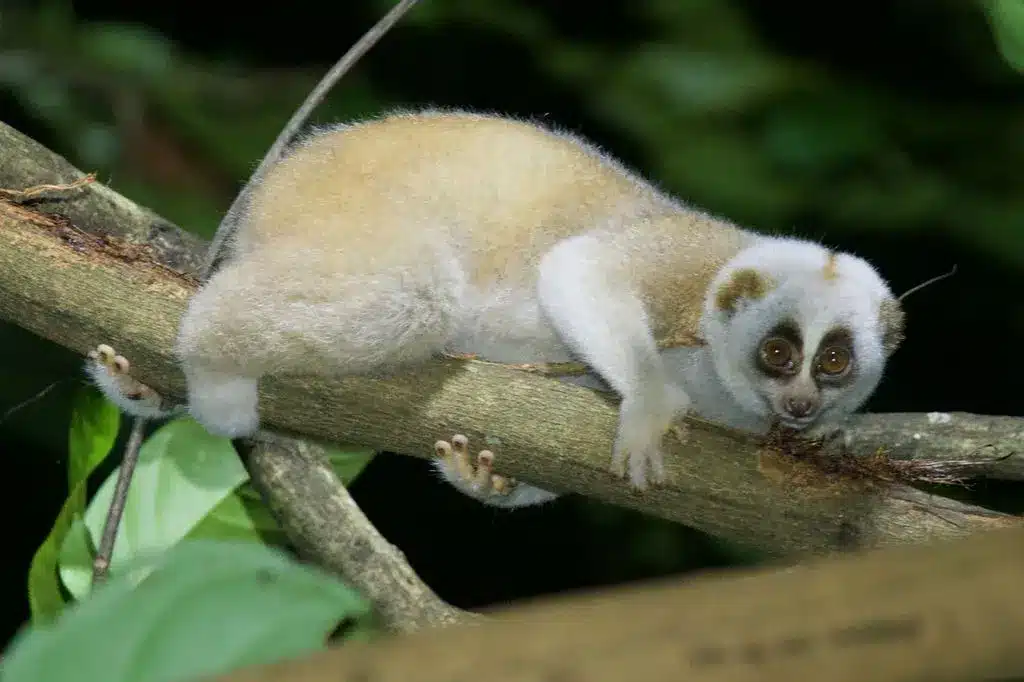About Slow Loris:
- Found exclusively in South and Southeast Asia, slow lorises are the world’s only venomous primates.
- They’re arboreal—meaning they live in trees—and can be spotted curling up to sleep in branches or using vines and leaves to get around.
- They typically only come down to the forest floor when they need to defecate.
- There are nine species of slow loris. They all belong to the same genus, with each species sharing many similar characteristics and behaviours.
- The nine species include the Philippine slow loris, Bengal slow loris, greater slow loris, Kayan slow loris, Bangka slow loris, Bornean slow loris, Sumatran slow loris, Javan slow loris, and pygmy slow loris.
- Bengal slow loris (Nycticebus bengalensis) is listed as Endangered in the IUCN Red List. It is also legally protected under the Wildlife Protection Act, 1972.
- The range of the Bengal slow loris extends from Vietnam to China, but in India, it is confined to India’s northeast.
- Features of Slow Lorises:
- These small, nocturnal creatures are characterised by their large, round eyes, which are adapted for night vision.
- They have compact bodies, short snouts, dense fur, and distinctive facial markings.
- On average, they measure 20 to 37 centimetres (or 10 to 15 inches) long.
- Slow lorises each have a small bare patch under their arm that secretes oil. When they feel threatened, they lick this oil, which combines with their saliva tocreate a venom strong enough to kill small arthropods and mammals.
- Slow lorises are skilled hunters; they use their slow and deliberate movements to catch prey like insects and small vertebrates.
- They also have a specialised toothcomb—a unique structure created by their bottom front teeth—that they use for groomingand extracting gum from trees.
- Slow lorises are generally solitary and territorial animals. They have the ability to stay motionless for long periods.
- They are omnivores.
Q1: What is IUCN?
The International Union for Conservation of Nature is a global organization composed of governments, NGOs, scientists, and experts dedicated to conserving nature and promoting sustainability. Its primary role involves assessing the conservation status of species, providing data and analysis on the state of biodiversity worldwide, and offering guidance and frameworks for conservation efforts.
Last updated on December, 2025
→ Check out the latest UPSC Syllabus 2026 here.
→ Join Vajiram & Ravi’s Interview Guidance Programme for expert help to crack your final UPSC stage.
→ UPSC Mains Result 2025 is now out.
→ UPSC Notification 2026 is scheduled to be released on January 14, 2026.
→ UPSC Calendar 2026 is released on 15th May, 2025.
→ The UPSC Vacancy 2025 were released 1129, out of which 979 were for UPSC CSE and remaining 150 are for UPSC IFoS.
→ UPSC Prelims 2026 will be conducted on 24th May, 2026 & UPSC Mains 2026 will be conducted on 21st August 2026.
→ The UPSC Selection Process is of 3 stages-Prelims, Mains and Interview.
→ UPSC Result 2024 is released with latest UPSC Marksheet 2024. Check Now!
→ UPSC Prelims Result 2025 is out now for the CSE held on 25 May 2025.
→ UPSC Toppers List 2024 is released now. Shakti Dubey is UPSC AIR 1 2024 Topper.
→ UPSC Prelims Question Paper 2025 and Unofficial Prelims Answer Key 2025 are available now.
→ UPSC Mains Question Paper 2025 is out for Essay, GS 1, 2, 3 & GS 4.
→ UPSC Mains Indian Language Question Paper 2025 is now out.
→ UPSC Mains Optional Question Paper 2025 is now out.
→ Also check Best IAS Coaching in Delhi

















